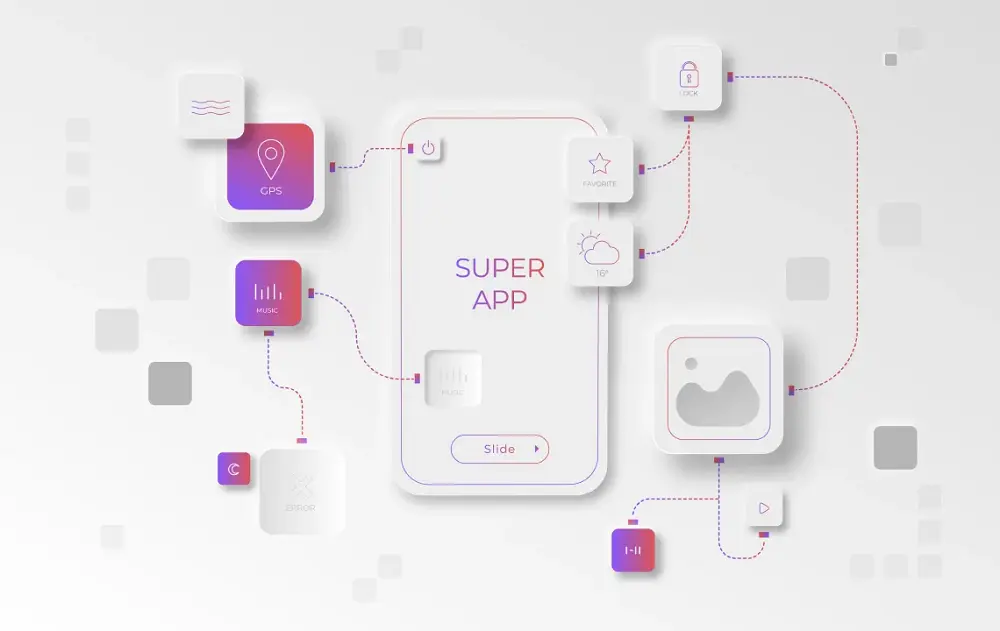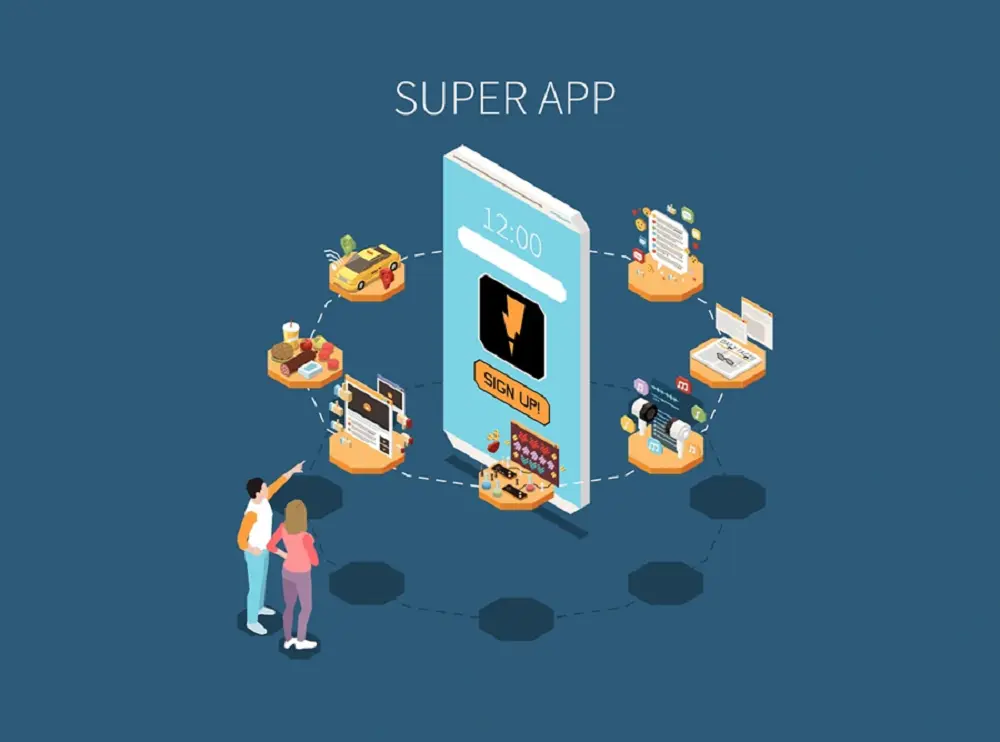Fintech companies are shifting toward super apps for a simple reason: user behavior has changed. Most users don’t want separate apps for payments, investing, and banking anymore. They want “one app for managing their entire digital lives“, fast and easy.
At the same time, competition in fintech is getting tighter. Acquiring new users costs more, while keeping existing ones is harder than ever. Super apps give fintechs a way to solve both by offering more value inside one ecosystem and using cross-selling to increase customer lifetime value.
This is a strategic move to stay relevant in a crowded market, build stronger customer relationships, and open up new revenue streams without constantly chasing new downloads.
This article breaks down what fintech super apps really are, why they matter for your business, and how to approach building one the right way.
What makes a fintech super app stand out?
A fintech super app is an all-in-one platform that brings together multiple financial services from payments, banking, investing, lending, and more, under one ecosystem. Unlike single-purpose apps, super apps aim to create a connected customer journey. Each service feeds into another, helping businesses improve engagement, retention, and cross-selling opportunities.
That’s what sets them apart. Instead of building standalone tools, super apps unify everything users need into one experience.

Giants like WeChat in China is a prime example of a successful super app, with over a billion users. The platform seamlessly blends messaging, payments, shopping, and even government services, becoming an essential part of daily life for millions. Similarly, Southeast Asia’s Grab has evolved from a ride-hailing app to a financial powerhouse. Today, it offers food delivery, payments, micro-investments, and insurance, all in one place.
Now, let’s explore the unique features that make these apps a leading choice in the financial industry.
Core features of fintech super apps
These are the essential pillars every fintech super app should include.
Payments & everyday transactions
One of the most basic user needs is fast and seamless payment. Users expect quick, reliable, and integrated ways to complete their daily financial tasks such as transfer money, scan QR codes, pay bills, and shop online.
Your super app should include digital wallets, QR payments, and peer-to-peer (P2P) transfers. Many other super apps also connect with external services like eCommerce or utility platforms to make payments part of everyday habits.
This builds user stickiness and create high-frequency engagement that keeps customers within your ecosystem.
Banking & credit access
After payments, users expect full control of their financial lives which means managing accounts, moving funds, and accessing credit directly inside the app.
To meet this need, key functions should include mobile banking, fund transfers, instant loans, credit scoring, and virtual or physical credit cards.
This unlocks new revenue streams and cross-selling opportunities through lending, deposits, and transaction fees.
Wealth & protection
As financial habits mature, users look for tools to grow and protect their money. Super apps can integrate investment and insurance services into the same platform which offers access to stocks, mutual funds, digital assets, or policy management tools.
These services not only simplify user experience but also position the app as a trusted financial advisor, driving long-term retention and profitability through higher-value services.
Personalization & insights
Beyond transactions, users need guidance. A strong super app provides personalized insights that help them make smarter financial decisions.
AI- and ML-powered tools can analyze spending habits, track budgets, set savings goals, and recommend products or investments that fit each user’s behavior.
In turn, it helps increasing session time, building trust, and driving loyalty through data-driven personalization.
Trust & support infrastructure
No super app can scale without trust. Users expect their data and transactions to be secure and always available when needed.
This means using strong security protocols such as encryption, two-factor authentication, biometrics, and fraud monitoring, alongside AI-powered chatbots or human-assisted customer support.
These features will strengthen brand reputation, maintain compliance, and reduce churn by ensuring a safe, reliable user experience.
So, what does all of this look like in action? Below are some of the world’s top fintech super apps that have turned these concepts into powerful ecosystems.
Top 6 fintech super app examples
These top fintech super apps illustrate how companies turn a single core service into a full-scale financial ecosystem. The table below compares their origins, monetization strategies and market reach. This is the strategic blueprint many are following in 2025.
| Apps | Core service | Financial services | User base | Market focus | Monetization | Strengths | Weaknesses |
|---|---|---|---|---|---|---|---|
| WeChat Pay (China) | Mobile payments | Payments, wallets, banking, investments, insurance, microloans, e-commerce | 1.2 billion | China | Transaction fees, interest on loans, investments, advertising | Massive user base, wide range of services, integration with WeChat ecosystem | Heavy reliance on Chinese market, concerns over data privacy |
| Grab (Southeast Asia) | Ridesharing, delivery | Payments, wallets, loans, investments, insurance, delivery, travel | 234 million | Southeast Asia | Transaction fees, commissions, advertising | Dominates transportation and delivery in Southeast Asia, expanding financial services | Dependence on transportation and delivery sector, potential regulatory challenges |
| Venmo (USA) | P2P payments | P2P payments, social features, credit building | 70 million | USA | Transaction fees, advertising | Popular P2P payments platform, social features, integration with other apps | Dependence on social network for growth, limited financial services outside P2P payments |
| Gojek (Southeast Asia) | Ridesharing, delivery | Payments, wallets, loans, investments, insurance, delivery, food, grocery | 25 million | Southeast Asia | Transaction fees, commissions, advertising | Diverse offerings, strong app experience, local market expertise | Overcrowded market in Southeast Asia, need for differentiation |
| Revolut (Europe) | Banking | Banking, investments, forex, crypto, insurance | 20 million | Europe | Subscription fees, interchange fees, interest on loans | Modern banking experience, focus on mobile, competitive exchange rates | Limited product range compared to larger players, regulatory hurdles |
| Chime (USA) | Banking | Banking, credit cards, early paycheck access, savings goals | 16 million | USA | Fees, interchange fees, interest on loans | Accessible banking, early paycheck feature, focus on budgeting | Relatively new entrant, limited brand recognition |
Here’s what we can learn from them:
- Start with a sticky core service. Every successful super app from chat (WeChat) to mobility (Grab, Gojek) to digital banking (Revolut), began by dominating a single, high-frequency need. This foundation creates daily engagement and data leverage.
- Expand through ecosystem synergy. Real growth happens when services work together, not separately. Payments lead users to lending, lending leads to savings, and savings open the door to insurance. Each layer strengthens the next, creating a self-sustaining ecosystem that keeps users coming back.
- Localize deeply, scale strategically. The strongest players grow local before going global. They adapt to local habits, compliance, and market needs first, then scale with confidence. Grab and Paytm are good examples of how cultural understanding and regulatory agility translate into long-term reach.
For fintech leaders, the super app trend is less about “doing everything” and more about owning the customer journey.
Start with one use case that solves a real problem, then expand naturally through related services that enhance user experience. Pay attention to the fundamentals early on: data, security, and compliance. These are not side projects; they are what give you the freedom to innovate later. When done right, it turns your fintech product from a tool into a daily habit, and from a habit into a business moat.
Business benefits and challenges
Understanding what makes these leaders successful also reveals the trade-offs behind this model. For businesses considering the super app path, it’s time to weigh the benefits and drawbacks, not just in theory, but in real operational impact.
Opportunities
For fintech companies, the super app model opens the door to long-term customer retention and higher revenue per user. When offering multiple financial services under one roof, businesses can increase engagement frequency meaning users check the app daily instead of weekly. Companies that successfully layer adjacent services like payments, credit, and insurance often see significantly higher retention and cross-sell rates compared to single-service apps.
Super apps also unlock new revenue streams without expanding customer acquisition costs. A single platform can monetize through lending interest, wealth management fees, insurance partnerships, or premium memberships. For example, Grab and Paytm both leveraged their payment ecosystems to launch lending and investment products, driving double-digit growth in transaction volume.
Operationally, a unified app also simplifies data collection and analytics. With one ecosystem, fintechs can better understand user behavior, personalize recommendations, and improve lifetime value, something fragmented apps struggle to achieve.

Risks
However, building a fintech super app is not without challenges. The first and most obvious barrier is complexity. Integrating multiple financial products, APIs, and compliance layers multiplies the technical debt and operational risks. Development costs can easily exceed 1.5–2 times those of a single-function app.
Security and data privacy risks also rise sharply. The more services you integrate, the more entry points for potential breaches. Regulatory scrutiny is another concern, especially when expanding across regions with different financial laws. Super apps like Grab and GoTo have faced delays and penalties due to evolving compliance requirements.
Also, there’s the strategic risk of overextension. Not every company needs to be a super app. Without a strong core product or clear value synergy, expansion can dilute focus and confuse users, ultimately hurting retention instead of improving it.

The future outlook for fintech super apps
As markets mature and regulations evolve, several trends are shaping what the next generation of fintech super apps will look like.
1. AI-driven personalization becomes the core engine
Artificial intelligence is moving from “nice-to-have” to essential infrastructure. Future super apps will rely on predictive models to tailor products, detect fraud faster, and anticipate user needs in real time. For fintechs, this means shifting from serving customers to advising them, turning data into trust and loyalty.
2. Consolidation is accelerating
The race to become a one-stop financial platform is driving mergers, acquisitions, and ecosystem partnerships. Instead of building every capability in-house, we’ll see more strategic integrations between banks, fintech startups, and even telcos. Each bringing their unique strength to the table. Market dominance will come from smart collaboration, not isolation.
3. Regulation will shape competitive advantage
As regulators tighten control around digital finance, compliance will evolve from a hurdle to a differentiator. Super apps that build transparent, auditable, and secure systems early will scale faster and face fewer interruptions when entering new markets. In other words, compliance maturity becomes a growth enabler.
4. Western markets are catching up
While Asia pioneered the super app model, the West is beginning to adapt it in its own way. PayPal, Revolut, and Cash App are expanding from single-function fintechs into integrated ecosystems. This shift signals that super apps becoming a global strategy for customer ownership.
5. Embedded finance will blur industry boundaries
Fintech super apps will increasingly power services beyond finance, from retail and travel to health and education. Embedding payments, credit, or insurance into non-financial experiences will make finance invisible but ever-present, unlocking massive cross-industry opportunities.
In short: the future of fintech super apps will be defined by who builds the smartest ecosystem, ne that connects value, data, and trust seamlessly.
For fintech leaders ready to act on these shifts, the next step is understanding how to build and scale a super app effectively.
Roadmap: How to build a fintech super app
Here’s a practical, step-by-step guide to help your business plan the journey.
Phase 1: Define your core value and target segment
Before diving into development, identify the anchor service that will attract and retain users (payments, lending, or wealth management). This core use case should solve a real pain point and serve as the entry point for your broader ecosystem. If you’re still defining your starting point, our guide on how to create a fintech app provides a clear decision framework.
Phase 2: Build an MVP around that core
Start small, validate fast. Your MVP should deliver one seamless experience with flawless usability and security. Focus on gathering user feedback, monitoring engagement, and refining UX/UI. These early signals will shape your next growth decisions.
Phase 3: Expand through modular features
Once your core service gains traction, gradually integrate complementary features (digital wallets, investment tools, or micro-lending) using an API-first approach. Each new service should enhance user stickiness and cross-sell potential, not overcomplicate the experience.
Phase 4: Ensure compliance and security
As your ecosystem grows, so do the risks. Make data protection, encryption, and KYC/AML compliance a core part of your infrastructure, not an afterthought. If you need to learn more about security, this guide – fintech app security will help you.
Phase 5: Scale through data and partnerships
Once the core is strong and secure, focus on scale. Use data analytics to personalize experiences and recommend financial products that add value to each user. Strategic partnerships with banks, insurers, or telecoms can further expand your reach and accelerate user acquisition.
Of course, having the right roadmap is only half the challenge. Turning that plan into a working, scalable product takes experience, and often, the right partner by your side.
- Related: 13+ Best fintech app development companies in 2025
Building fintech super apps with Synodus
Synodus is a full-cycle software development partner trusted by global enterprises and startups in fintech, public, and enterprise sectors.
We’ve helped fintechs and financial institutions across Asia build multi-service platforms, from digital banking and payments to credit, wealth, and blockchain-based tools. Our strength lies in turning fragmented ideas into scalable ecosystems that grow with your users and meet compliance from day one.
When you partner with us, you get a product team that helps you:
- Define a realistic MVP for your super app vision.
- Build faster with proven fintech modules and API integrations.
- Ensure compliance with financial regulations across regions.
- Continuously improve user retention and monetization post-launch.
If you’re planning to build your own fintech super app, let’s start with a short conversation. We’ll help you map out the path from idea to impact.
Wrapping up
Fintech super apps are not just a trend, they represent the future of digital finance. By unifying diverse services into one platform, they deliver unmatched convenience, personalization, and efficiency. As user expectations continue to evolve, these apps will remain at the forefront of transforming how we mange money in a digital-first world.
How useful was this post?
Click on a star to rate it!
Average rating / 5. Vote count:
No votes so far! Be the first to rate this post.




